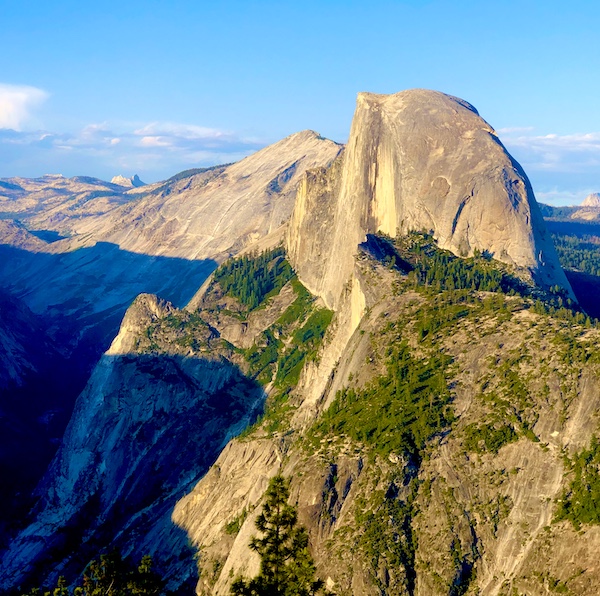
It’s easy to stay put in San Francisco. The city is rich in recreational activities, from some of the best maintained and most varied public parks in the country, to beaches, urban hiking trails, and a wealth of arts and culture.
Ironically, another of the city’s most enviable attributes is how easy it is to get away from, to environments that feel altogether different.
Over the summer, my partner John and I took two short, refreshing overnight road trips that delivered major changes of scenery with minor fuss and planning. We travelled east to the Mariposa Valley and Yosemite National Park, and north to the Anderson Valley.
A rule of the road
When planning a car trip out of the city, my rule of thumb is that drive time (round trip) should clock in at no more than 30% of the time you want to spend in and around your destination.
That will give you enough time on the road to crack the windows, crank the music and feel like you’re putting some real distance between yourself and your regular daily life without making you feel like you’re under pressure or on a slog.
Overambition can be such a spoiler.
Having to hit the highway at the crack of dawn (especially when heading back home) undermines the sense of relaxation you’re striving for. And not enough time to settle in at your destination can be frustrating, making your anticipated “me time” feel like one big U-turn.
If you’re spending one night away from home, pick lodging that’s no more than a four hour drive from your starting point. Each of our trips took about 3 hours in late morning weekday traffic, with some additional road time for sightseeing around our accomodations.
Home sweet Mariposa
Our eastbound itinerary was a full-family trip: John and I were accompanied by Ollie, our 45-pound terrier mutt. That meant identifying a pet-friendly place to stay.
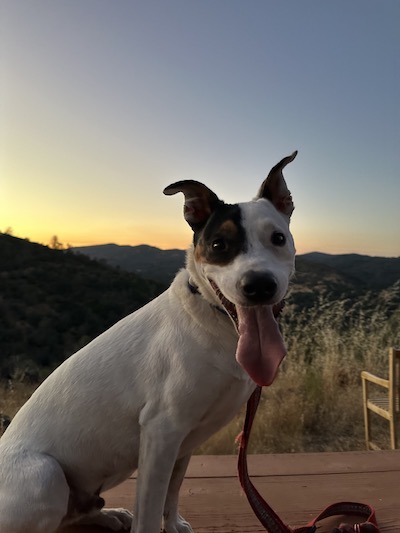
We lucked out with Wildhaven Yosemite just outside the town of Mariposa, which not only welcomes dogs, but is in pristine condition, having just opened just this past April.
The newest overnight accommodation in close proximity to the United States’ sixth most-visited national park,featuring 30 platform-mounted tents and 12 minimalist modern air-conditioned cabins that rise above rusticity in both their unworn freshness and tidy design.
The gentle hills of Wildhaven’s 36-acre grounds abut a further sprawl of 2,000 protected acres, providing a welcome sense of remoteness. Easy hiking trails wind through the property-perfect for dog walking-with benches situated at several viewpoints. From a hilltop pergola, we watched the sere Sierra Foothills take on an amber glow as the sun set to the southwest.
While a low-slung reception building at the entrance to the property, just off Highway 140, doubles as a general store selling cold drinks, ice, and some basic groceries, most guests will want to bring along a cooler with dinner fixings. A cooking area with shaded picnic tables; five clean, well-maintained propane grills; and plenty of barbecue utensils are available to all guests (Cabin guests also have their own kitchenettes with mini-fridges, two-burner cooktops, basic cookware, and utensils).
We stayed in a 168-square-foot tent with transparent plastic windows 9-foot ceilings. lamps, and, most importantly, a comfortable queen-sized bed. There were conventional and USB outlets and slow, but always functioning, wifi. Our tent platform also included an outdoor sitting area with table and chairs, where we snacked on wine and cheese brought from home.
Initially slightly wary about the toilet and shower facilities in the bathhouse building that tent guests all share, we were pleasantly surprised by their cleanliness and by the privacy provided by the thoughtful layout.
Wildhaven’s cabins, which range from 180 to 240 square feet of indoor space, including private bathrooms, are inspired by the tiny home movement. The outdoors is brought in through large picture windows and skylight; and each cabin also has a furnished patio area. (Like the tents, all cabins have heaters and fans, and some even offer air-conditioning).
Wildhaven Yosemite remains open through October, with rates starting from $129 for tents to $199 for cabins.
Yosemite sampler
Having thoroughly disconnected and chilled out during our visit to Wildhaven, I’d happily go there again just to hole up and stroll the grounds on a personal retreat. But our first visit, as it is for most guests, was built around a brief visit to Yosemite National Park.
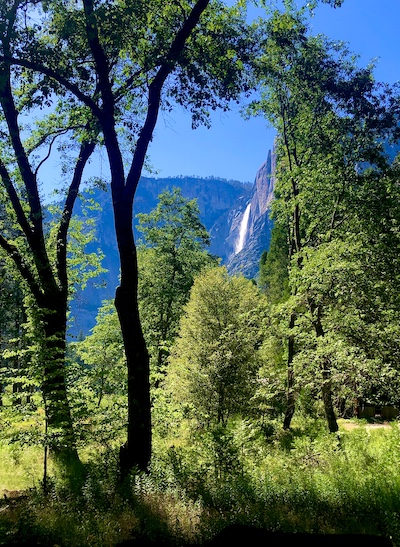
Yosemite virgins often don’t realize just how easily accessible the park is from the Bay Area. And they also may not realize how enjoyable it can be for non-roughing-it, road tripping types.
A stunning 45-minute mountainside drive along Highway 140 from Wildhaven brought us to the park’s Arch Rock entrance just past the small town of El Portal.
One needn’t scale Half Dome or El Capitan to appreciate the grandeur of these quartz and granite giants. In fact, if you’ve got your dog with you, you’re not allowed.
While most hiking trails are off-limits to canines, virtually all of Yosemite’s ample paved paths and overlooks are available to leashed pooches. The picture postcard views and woodland aromas are anxiety-erasing wonder drugs.
Among the most beautiful-and easiest-walks on which dogs are allowed is the Bridalveil Fall path. The first waterfall you’ll see as you drive into the park, its cascade has an elegant, cord-like sway as it plummets 620 feet toward the meadow.
From the Bridalveil parking lot, it’s just a half mile stroll on a modest incline to the base of the fall.
While one could spend weeks hiking and camping in the park’s nearly three-quarter-million acres, a half day’s driving loop with intermittent short walks (with or without a pet) will easily put you in its thrall. And autumn offers optimal photo ops.
A $35 per vehicle fee is required to enter the park. Between now and October 27,
visits on Saturdays, Sundays, Labor Day and Indigenous People’s Day require a reservation, which can be made for $2 online. (https://www.nps.gov/yose/planyourvisit/reservations.htm )
Anderson super
Just under three hours from San Francisco, and well worth an overnight stay, is the Anderson Valley, a wine region lesser ballyhooed than Napa and Sonoma and consequently lesser trafficked.
And, while the Russian River Valley has long been known as a gay haven, queer entrepreneurs are behind some of this northerly neighbor’s most appealing attractions.
Once you cross the Golden Gate Bridge, it’s pretty much a straight 120 mile shot up Highways 101 and 128 to the town of Boonville. And in the mere seven mile stretch between Boonville and Philo, you’ll find plenty to keep yourself busy for a couple of days—and a couple of wonderful spots to lay your head for the night.
John and I are true Fandersons, so this summer’s road trip to the region was by no means our first. Autumn, in fact, is the most glorious season to visit, with an East Coast-worthy display of fall colors.
Every time we head up that way (sometimes following 128 another 10 miles or so beyond Philo to the Mendocino Coast), our first stop is Pennyroyal Farm.
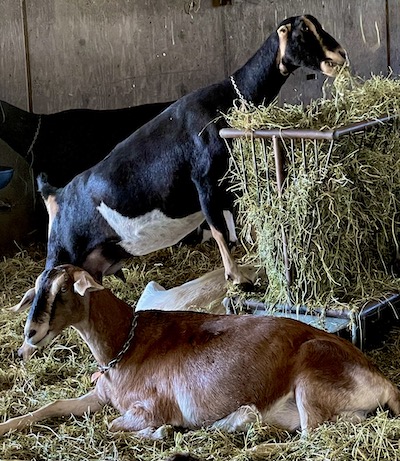
It’s the living laboratory of agricultural power couple Sarah Cahn Bennett and Erika Scharfen, who met in a goat husbandry class at U.C. Davis. The pair take the concept of terroir terribly seriously, making estate wine in vineyards that are weeded and fertilized by the same resident herds of goats and sheep who produce the milk used in Pennyroyal’s extraordinary cheeses.
To taste a pairing of these mutually supportive delicacies is to begin understanding the value of sustainable farming, and to speak at length with Bennett, Scharfen or one of the couple’s savvy staff is to learn much more.
John and I did both on a visit that included a guided farm tour and a cheeseboard lunch. Among the cheeses developed by Scharfen, who runs the farm’s dairy operation, is semisoft Bollie’s Mollies, made from a blend of sheep and goat’s milk. It’s both creamy and tangy, and marries beautifully with winemaker Bennett’s unique Pinotrio, a blend of Blanc, Noir, and Gris.
Pennyroyal’s wine and cheese tasting room is open daily, with farm tours offered at 10:30 a.m. and special events are held throughout the year: On October 5, there will be an outdoor film screening in conjunction with the Mendocino Film Festival (Last year’s feature was, cleverly, “Shaun, the Sheep Movie,” with cheesy refreshments on offer).
Also in Boonville, queer oenophile and forme Texan Wendy Lamer oversees Disco Ranch, the chicest general store you’ve ever encountered, with mind-boggling selection of semi-obscure international wines that Lamer relishes introducing to newbies.
Disco Ranch also has everything you need for a gourmet picnic—including the tables to eat it, on the umbrella shaded, quirkily decorated front patio (That’s where you’ll find the namesake mirrored ball).
Between Pennyroyal and Disco Ranch, you can also pull together all the provisions you need to cook up a private feast to enjoy in the confines of one of the two private guest houses at Stoney Bottom, an inn and historic garden now owned and operated by gay couple Dominic Phillips and James Gregory, a dentist who practices in San Francisco.
Phillips, a native Scot and former event management executive, oversees hospitality on site. A contemporarily decorated one-bedroom cottage and two-bedroom house sit remote from each other, offering options for romantic couples or road-tripping quartets.
Finally, Philo
Among the over two dozen wineries in the Anderson Valley-including Scharffenberger, Husch, and Maggy Hawk-our favorite is Philo’s Goldeneye, for its rich, mouthfilling Pinot Noir and surprising California Gewurtztraminer, but also for its enchanting indoor-outdoor tasting room.
The sweeping vineyard views, mesmerizing fountain and gracious service feel far more personal and attentive than most of Napa and Sonoma’s tourist-churning operations. And multi-varietal tastings begin at a modest $25, a bargain in Northern California these days.
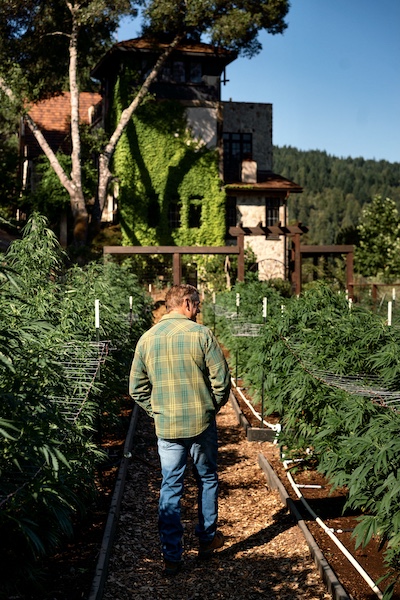
Philo is also home to The Madrones, a Tuscan-style boutique hotel, that serves as the centerpiece for the burgeoning Anderson Valley empire of gay couple Jim Roberts and Brian Adkinson,
Roberts, a second generation vineyard owner, has expanded his focus to include another intoxicating cash crop: Cannabis.
“My mother was growing pot when I was back in high school in the ‘70s,” says Roberts, who, with the legalization of cannabis in California, has become a pioneer in both organic, regenerative marijuana cultivation and the development of cannabis-connoisseur tourism.
Along with elegant, antique-accented guest rooms, tasting rooms for two local winemakers, and an eccentrically curated gift shop, the Madrones complex includes the Bohemian Chemist, Roberts and Adkinson’s 1920s apothecary-style dispensary and education center, selling its own house brand flower, pre-roll, and vape products.
At the duo’s nearby Sugar Hill Farm, their crops include rare cultivars with Vietnamese, Malawian, and Swazi origins. Partnering with academic agricultural researchers, they are studying the synergistic effects of various plant compounds in varying combinations in an effort to develop proveably functional strains.
Following the model established by wineries, the Bohemian Chemist offers a subscription club with thrice annual offerings, a tasting room aka “partaking area” on the hotel grounds, and special events including farm tours and culinary pairing meals.
